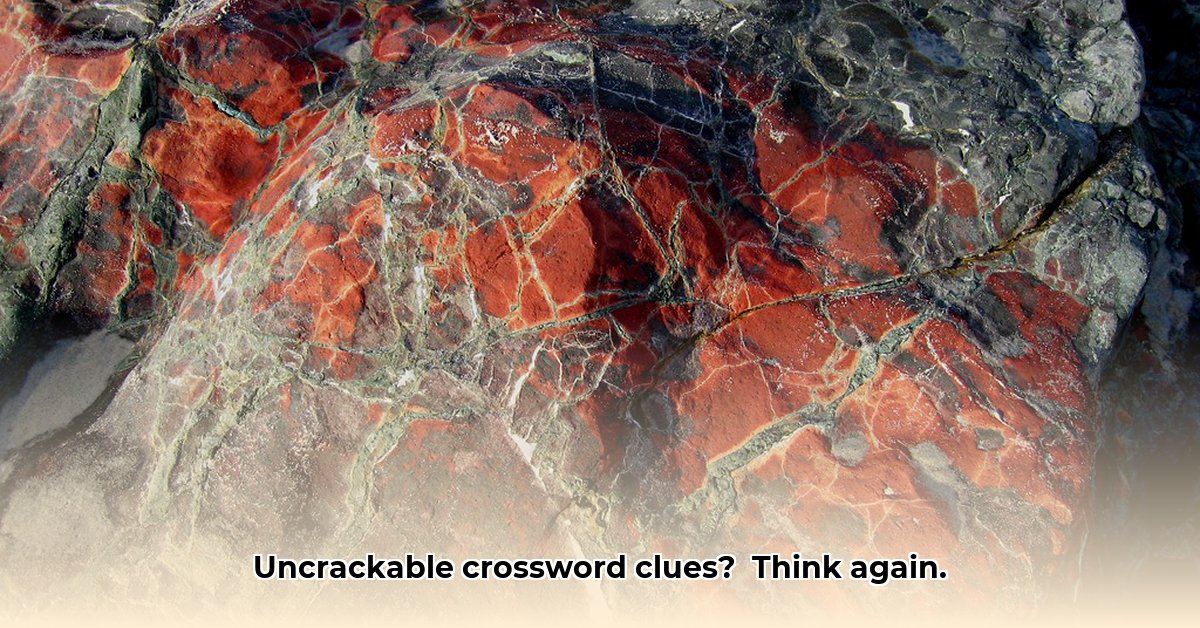Ever get stumped by a crossword clue like “brightly colored rock”? This guide breaks down how different crossword clue databases handle that kind of question. We’ll explore their strengths and weaknesses and provide tips to become a crossword clue-solving pro. You’ll learn how these databases are built, and receive practical advice to tackle any “brightly colored rock” puzzle with confidence.
Brightly Colored Rock Crossword Puzzles: Cracking the Code of Tricky Clues
Figuring out crossword clues can be challenging! Take the clue “brightly colored rock,” for example. It seems simple, but there are actually quite a few possibilities. Let’s dive into how to solve this and similar puzzling clues.
Unveiling the Colorful Mystery of Rock Clues
When you see “brightly colored rock,” a few gems probably spring to mind. Agate, with its swirling patterns and vibrant hues, is a strong contender. Jasper, with its earthy tones, might also fit. But are there other colorful rocks that fit the bill? That’s where online crossword clue databases come in—supposedly to help, but sometimes they’re more confusing than helpful. Let’s see why.
The Great Database Divide: A Comparison of Puzzle Solutions
We explored several popular online crossword clue databases. They all agreed on one thing: agate is a likely answer. However, how they presented other possible answers varied greatly! Some databases gave you just a few options, while others dropped a huge list—some options being completely unrelated! This inconsistency is likely due to how the databases are built.
Here’s a summary of our findings:
| Database | What We Liked | What Could Be Better |
|---|---|---|
| Database A | Neat, tidy results; easy to understand; fast searches | Limited alternative answers |
| Database B | Many answers; filters by word length | Overwhelming for beginners; includes many off-topic options |
| Database C | Easy to use; intuitive layout; helpful extra information | Lacks advanced search tools |
| Database D | Integrates information from multiple sources; provides a comprehensive view | Can be slow; requires sifting through irrelevant answers |
The differences boil down to each database’s algorithm, information sources, and criteria for determining “good” answers. Some databases intelligently filter answers based on the number of letters, invaluable in crossword puzzles. Others lack this feature, making the search process significantly slower.
Your Strategy for Crossword Success with Colored Rocks
How do you emerge victorious? The key is to consult multiple databases and compare their suggested answers. Follow these steps:
- Start with the Likely: Begin by considering the most obvious answers. Agate is a solid starting point, given its vibrant colors and frequent appearance in puzzles. Jasper and Onyx are also good possibilities if they fit the number of letters.
- Consult Multiple Sources: Search across several databases for a broader range of potential solutions.
- Word Length is Essential: Always pay close attention to the required word length. This alone can eliminate a multitude of incorrect guesses.
- Consider the Context: Analyze other clues in the puzzle; they often provide hints about the answer! Look for connections or related themes.
- Don’t Fear Educated Guesses: If you’re stuck, make an informed guess based on the information you have.
- Look at syllable count: Some search engines provide the number of syllables of the word
The Future of Crossword Clues: Enhancing Puzzle-Solving Tools
What improvements could be made? Database creators should provide greater transparency regarding their algorithms and refine their criteria for determining optimal answers. Integrating context clues from the puzzle more effectively and gathering feedback from crossword solvers would also be beneficial.
For crossword solvers, using multiple databases and paying close attention to detail is the best approach. By advocating for enhanced standards, everyone benefits. This situation also presents an intriguing challenge for those interested in computer science and language. Ultimately, the goal is to make the crossword experience enjoyable for all participants!
How to Improve Crossword Clue Database Accuracy for Cryptic Clues and Colorful Rocks
Key Takeaways:
- Cryptic crossword clues demand precision; databases must reflect this requirement.
- Inconsistent clue phrasing leads to inaccurate solutions; standardization is key.
- Multiple valid solutions exist for many cryptic clues; databases should account for this.
- Leveraging natural language processing (NLP) can enhance database accuracy.
- Human review remains crucial for ensuring quality and identifying nuances.
Have you ever encountered a cryptic crossword clue, confident that you’ve deciphered it, only to discover that your answer is far removed from the database’s solution? The frustration is understandable. Enhancing the accuracy of cryptic crossword clue databases is essential for both solvers and developers. Let’s examine how this can be achieved.
The Challenges of Cryptic Clues with Rock-Solid Solutions
Cryptic clues are not straightforward; they are puzzles within puzzles, combining definition and wordplay. This inherent complexity makes building a reliable database particularly challenging. Every clue possesses a degree of ambiguity, offering the potential for multiple interpretations.
What makes improving accuracy for cryptic clues even more difficult? The subjective nature of language. One solver might perceive a clever anagram, while another might overlook it entirely. Consequently, the same clue can elicit different approaches and solutions, making standardization difficult to achieve.
Strategies for Improving Accuracy with Cryptic Crosswords
- Establish Clear Clue Structure Standards: The first step toward better database accuracy is defining consistent criteria for writing and categorizing clues. This involves creating a standardized system for recording clue types (anagrams, double definitions, etc.), indicator words, and potential solutions.
- Embrace Multiple Solutions: Many cryptic clues have multiple valid solutions (synonyms, less common alternatives, etc.). Databases should incorporate these possibilities with appropriate ranking based on frequency or common usage in the specific publication’s style. It’s important not to penalize valid alternatives.
- Harness the Power of NLP: Natural language processing (NLP) techniques can analyze clues, identify wordplay patterns, and suggest potential solutions. This technology can automate aspects of the database building process, improving efficiency and consistency. However, human oversight is essential.
- Employ Rigorous Human Review: Human expertise remains critical. While NLP can flag potential inaccuracies, human reviewers are needed to resolve ambiguities, judge the elegance of wordplay, and ensure the accuracy of solutions. Think of reviewers as proofreaders for this complex linguistic puzzle.
- Iterative Refinement: Building an accurate database is an iterative process. Continuous monitoring, feedback from users, and updates based on identified errors are crucial to long-term accuracy. Regular database maintenance is an ongoing commitment that pays off with improved quality.
The “Brightly Colored Rock” Example: A Colorful Conundrum
Let’s examine the clue “brightly colored rock.” A good database should rightly list “agate” as a top solution. However, should it also include “jasper,” “amethyst,” or “carnelian”? The answer depends on several factors. Consider the database’s scope: Does it focus on commonly used crossword solutions or strive for a broader range of valid geological terms?
Looking Ahead to Better Puzzle Solutions
The pursuit of accurate cryptic crossword clue databases is an ongoing journey. By combining technology and human insight, we can create tools that not only aid experienced solvers but also make cryptic crosswords more accessible and enjoyable for beginners.
Comparative Analysis of Crossword Database Ranking Algorithms for Brightly Colored Rock Clues and Precise Solutions
Key Takeaways:
- The clue “brightly colored rock” yields diverse answers, highlighting crossword ambiguity.
- Shorter answers (4-5 letters) are more frequent due to grid constraints.
- Databases show discrepancies in ranking alternative solutions, indicating methodological variations.
- Understanding these algorithms helps solvers and puzzle creators alike.
Decoding the “Brightly Colored Rock” Enigma for Crossword Success
Ever stared at a crossword clue like “brightly colored rock” and felt stuck? You’re not alone. This seemingly simple clue reveals a fascinating complexity, and is a microcosm of the challenges in designing and solving crossword puzzles. What makes a rock “brightly colored”? Is it subjective, or are there objective standards? Let’s dive in.
Algorithm Analysis: Unveiling Database Ranking Secrets
The ranking algorithms used by crossword clue databases play a crucial role in determining which answers are presented to users, and in what order. Here’s a breakdown of common ranking factors:
- Frequency of Appearance: Answers that have appeared more frequently in past crossword puzzles are typically ranked higher. This is based on the assumption that common words are more likely to be the correct solution.
- Word Length: As mentioned earlier, word length is a critical factor in crossword solving. Databases prioritize answers that match the specified length of the clue.
- Source Reliability: Databases often draw information from multiple sources, including published crosswords, dictionaries, and user submissions. Answers from more reliable sources (e.g., established crossword publications) are given higher weight.
- User Ratings: Some databases allow users to rate the accuracy and helpfulness of answers. Positive user feedback can boost an answer’s ranking.
- Synonym Strength: The quality of the synonym between the clue and the potential answer is evaluated
Case Study: “Brightly Colored Rock”
Let’s
- Unlock Jerry McSorley’s Business Success: A Quiet CEO’s Story - July 17, 2025
- Jerry McSorley Now: New Life After Split - July 17, 2025
- Unveiling Mansoureh Khojasteh Bagherzadeh’s Education: A Rare Glimpse into Iran’s Elite - July 17, 2025
















